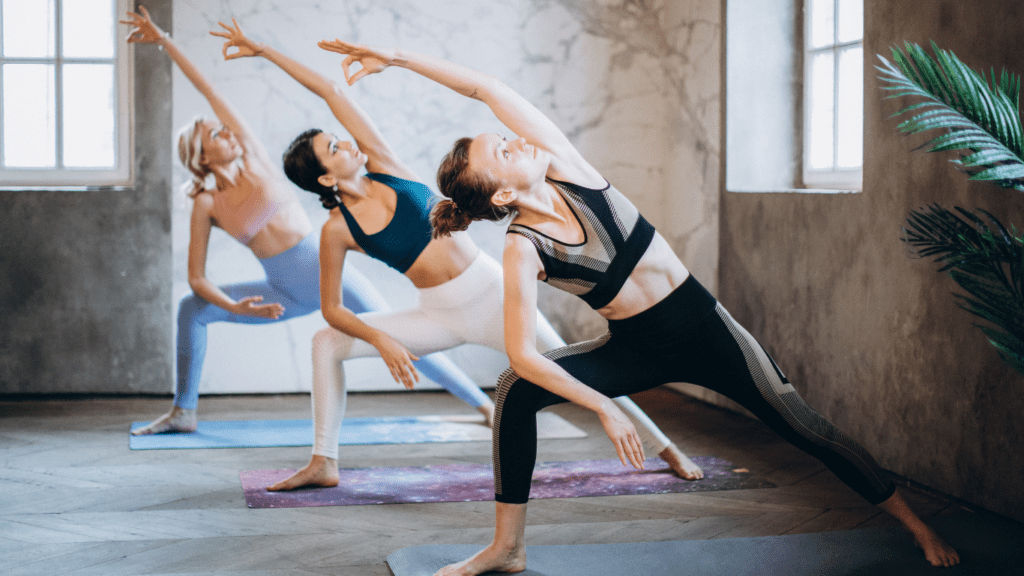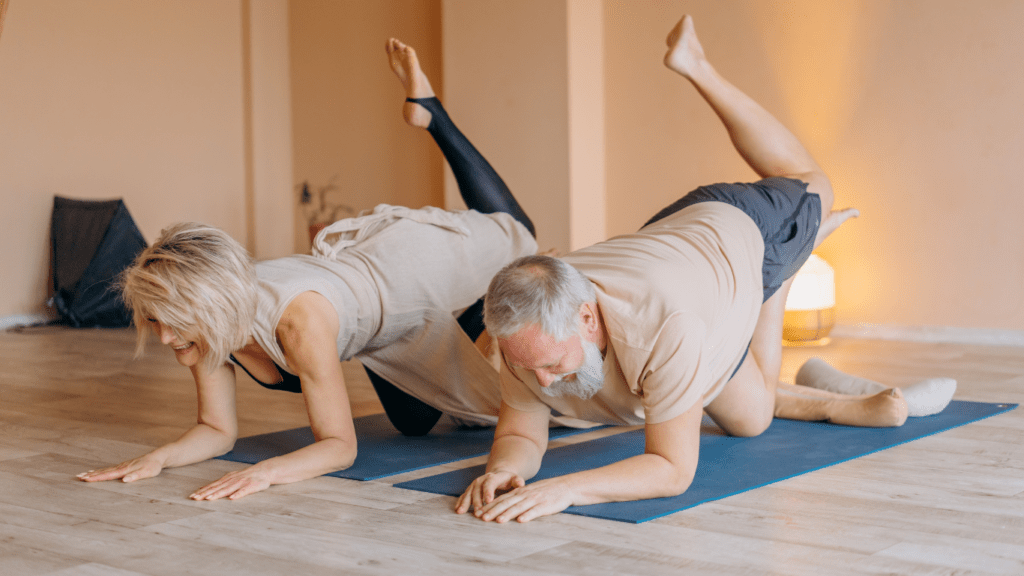Benefits of Yoga for Beginners
Starting yoga offers many benefits for beginners. It improves flexibility, which enhances ease and efficiency in everyday movements. Regular practice increases strength by engaging different muscle groups. Lower back pain, common among sedentary individuals, can be alleviated by poses that strengthen core muscles.
Yoga helps with stress reduction. Deep breathing exercises, combined with mindfulness, lower cortisol levels, which reduces anxiety. Improved respiration, due to controlled breathing, leads to better oxygen flow and relaxation.
Beginner yoga enhances focus and mental clarity. Balancing poses require concentration, promoting mental discipline. Memory improves as mindfulness practices train the brain to stay present.
Physical health also sees positive changes. Blood circulation improves, reducing blood pressure risks. Yoga also supports weight management by increasing metabolism and building muscle mass.
Starting yoga at home provides a personalized experience. It allows you to progress at your own pace, ensuring comfort and convenience. Engaging in regular practice establishes a healthy routine, laying a strong foundation for advanced poses and greater benefits in the future.
Essential Tips Before Starting
Set a Comfortable Space
Choose a quiet area for your practice. Ensure it has enough room to stretch, move, and place a yoga mat. Remove distractions like:
- noisy electronics
- clutter
- bright lights
A serene environment enhances focus and relaxation.
Wear Appropriate Clothing
Select comfortablle, breathable clothing. Tight or restrictive clothes can hinder movement and cause discomfort. Opt for stretchy materials like cotton or spandex. Proper attire allows free movement and better practice.
Gather Necessary Props
Equip yourself with basic yoga props. Essential items include a yoga mat, blocks, and a strap. Mats provide grip and cushion, blocks assist with balance and reach, and straps help with flexibility. These props support and improve your practice.
Warm-Up Your Body
Perform a gentle warm-up. Spend a few minutes doing light stretches or dynamic movements. Warming up prepares your muscles for activity, preventing injuries and enhancing performance when practicing poses.
Stay Hydrated
Hydrate before you begin. Drink water at least 30 minutes before starting your practice. Avoid drinking too much during the session to prevent discomfort. Proper hydration supports muscle function and overall well-being.
Focus on Breath
Pay attention to your breathing. Incorporate deep, mindful breaths in each pose. Inhale deeply through your nose, and exhale fully through your mouth. Controlled breathing improves relaxation and focus, deepening the practice.
Listen to Your Body
Honor your body’s limits. Avoid pushing into pain or discomfort. If a pose feels too intense, modify it or rest. Respecting your body’s signals prevents injury and promotes a sustainable yoga practice.
Follow Online Guidance
Utilize online resources. Many qualified instructors offer free classes and tips. Platforms like YouTube and specialized yoga apps provide guided sessions for beginners, making it easier to follow along at home.
Be Consistent
Practice regularly. Aim for short, daily sessions rather than occasional long ones. Consistency aids in building strength, flexibility, and a healthy habit. Regular practice leads to noticeable progress over time.
Easy Yoga Poses to Try at Home

Practicing yoga at home offers beginners a convenient and comfortable way to start. Here are easy poses that support flexibility, strength, and relaxation.
Mountain Pose (Tadasana)
Mountain pose forms the foundation of all other poses. Stand with feet hip-width apart, arms at sides. Engage thighs, lift chest, and relax shoulders. Imagine growing taller, from the crown of the head to the feet. This pose improves posture and balance.
Downward-Facing Dog (Adho Mukha Svanasana)
Downward-facing dog targets various muscle groups. Begin on hands and knees, fingers spread wide. Lift hips towards the ceiling, keeping knees slightly bent. Stretch heels towards the ground. This pose strengthens arms, legs, and back while increasing flexibility.
Child’s Pose (Balasana)
Child’s pose provides a gentle stretch and a moment of relaxation. Kneel on the mat, big toes touching, knees apart. Sit back on heels, extend arms forward, and rest forehead on the mat. Use this pose to rest between more challenging poses, as it gently stretches the lower back, hips, and thighs.
Cat-Cow Stretch (Marjaryasana-Bitilasana)
Cat-cow stretch mobilizes the spine. Start on hands and knees. Inhale, arch the back, lower the belly, and lift the head (cow). Exhale, round the back, tuck the chin, and engage the core (cat). Repeat for several breaths. This pose stretches the back, improves posture, and boosts circulation.
Cobra Pose (Bhujangasana)
Cobra pose strengthens the spine and opens the chest. Lie face down, legs together, hands under shoulders. Gently lift the chest off the ground, using back muscles. Keep elbows slightly bent, shoulders down. This pose alleviates fatigue and enhances spine flexibility.
Seated Forward Bend (Paschimottanasana)
Seated forward bend stretches the hamstrings and spine. Sit with legs extended, spine straight, and feet flexed. Inhale, lengthen the spine. Exhale, hinge at hips, and reach towards the feet. Keep the back flat. This pose calms the mind and improves flexibility.
Creating a Yoga Routine
Establishing a consistent yoga routine can enhance your practice and ensure steady progress. Here are key steps to create an effective and enjoyable routine at home.
- Setting Up Your Space
Select a quiet, clutter-free area at home. Ensure there’s enough room to move freely without obstacles. Use a yoga mat for comfort and stability, and gather props like blocks and straps if needed. Soft lighting and calming music can enhance the ambiance.
- Choosing the Right Time
Find a time that fits seamlessly into your daily schedule. Morning sessions can energize the body for the day ahead. Evening sessions help unwind and relax before bed. Consistency is key, so choose a time you can stick to.
- Listening to Your Body
Pay attention to how your body feels during each pose. If you experience any pain or discomfort, modify the pose or take a break. Over time, you’ll learn to recognize your limits and make adjustments to avoid injury and maximize benefits.
By addressing these components, you’ll set a strong foundation for your yoga routine, ensuring a balanced and fulfilling practice.
Resources for Beginners
Starting yoga at home can be empowering with the right resources. Here are online classes and recommended readings to guide your practice and deepen your understanding.
Online Classes and Tutorials
Plenty of online platforms offer yoga classes for beginners. Websites like Yoga with Adriene, Glo, and DoYogaWithMe provide structured lessons that cater to different levels. I recommend starting with beginner-focused playlists on YouTube, as they offer free content from experienced instructors. Many apps, such as Down Dog and Daily Yoga, offer personalized sessions based on your goals and experience level. Practicing with these online resources helps build confidence and ensures you’re performing poses correctly.
Recommended Reading
Several books provide a solid foundation for yoga beginners. “The Heart of Yoga” by T.K.V. Desikachar offers insights into the philosophy and practice of yoga. I recommend “Light on Yoga” by B.K.S. Iyengar for its detailed descriptions and illustrations of poses. For a modern take, try “Yoga Sequencing” by Mark Stephens, which provides sequences designed for beginners and helps you tailor your practice. Reading these books alongside your practice enriches your understanding and supports steady progress in your yoga journey.


 Paulah Simmonserly, the visionary behind News Flip Network, has built a platform that delivers timely and comprehensive news across multiple fields. With a deep passion for journalism and a commitment to keeping the public informed, Simmonserly ensures the site covers everything from global affairs to business trends, health insights, and sports updates. Her leadership emphasizes accuracy and relevance, making News Flip Network a trusted resource for readers seeking up-to-date information on the events shaping the world.
Paulah Simmonserly, the visionary behind News Flip Network, has built a platform that delivers timely and comprehensive news across multiple fields. With a deep passion for journalism and a commitment to keeping the public informed, Simmonserly ensures the site covers everything from global affairs to business trends, health insights, and sports updates. Her leadership emphasizes accuracy and relevance, making News Flip Network a trusted resource for readers seeking up-to-date information on the events shaping the world.